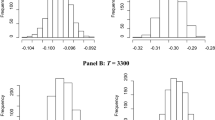Abstract
Expected Shortfall (\(\mathrm {ES}\)) is one of the most heavily used measures of financial risk. It is defined as a scaled integral of the quantile of the profit-and-loss distribution up to a certainly confidence level. As such, quantile regression (QR) and the closely related expectile regression (ER) methods are natural techniques for estimating \(\mathrm {ES}\). In this paper, we survey QR and ER based estimators of ES and introduce several novel variants. We compare the performance of these methods through simulation and through a data analysis based on four major US market indices: the S&P 500 Index, the Russell 2000 Index, the Dow Jones Industrial Average, and the NASDAQ Composite Index. Our results suggest that QR and ER methods often work better than other, more standard, approaches.






Similar content being viewed by others
Notes
A dimension reduction subspace is the column space of any matrix \(\mathbf {\Gamma }\) such that the response \(r_k\) and the vector of predictors \({\mathbf {r}}_{k,p}\) are conditionally independent given \(\mathbf {\Gamma }^{\top }{\mathbf {r}}_{k,p}\). The central subspace is the dimension reduction subspace with the smallest dimension.
References
Aigner, D. J., Amemiya, T., & Poirier, D. J. (1976). On the estimation of production frontiers: Maximum likelihood estimation of the parameters of a discontinuous density function. International Economic Review, 17, 377–396.
Artzner, P., Delbaen, F., Eber, J. M., & Heath, D. (1997). Thinking coherently. risk, 10. November, 68, 71.
Basel Committee on Banking Supervision. (2013). Consultative Document, Fundamental Review of the Trading Book: A revised Market Risk framework. Switzerland: Basel http://www.bis.org/publ/bcbs265.pdf).
Bollerslev, T. (1986). Generalized autoregressive conditional heteroscedasticity. Journal of Econometrics, 31(3), 307–327.
Broda, S. A., & Paolella, M. S. (2011). Expected shortfall for distributions in finance. In P. Cizek, W. K. Härdle, & R. Weron (Eds.), Statistical Tools for Finance and Insurance (pp. 57–99). Springer.
Chaudhuri, P., Doksum, K., & Samarov, A. (1997). On average derivative quantile regression. Annals of Statistics, 25(2), 715–744.
Christou, E. (2020). Central quantile subspace. Statistics and Computing, 30, 677–695.
Christou, E., & Grabchak, M. (2019). Estimation of value-at-risk using single index quantile regression. Journal of Applied Statistics, 46(13), 2418–2433.
Cont, R. (2001). Empirical properties of asset returns: Stylized facts and statistical issue. Quantitative Finance, 1(2), 223–236.
Ding, Z., Granger, C. W. J., & Engle, R. F. (1993). A long memory property of stock market returns and a new model. Journal of Empirical Finance, 1, 83–106.
Embrechts, P., Kaufmann, R., & Patie, P. (2005). Strategic long-term financial risks: Single risk factors. Computational Optimization and Applications, 32, 61–90.
Engle, R. F. (1982). Autoregressive conditional heteroskedasticity with estimates of the variance of U.K. inflation. Econometrica, 50(4), 987–1008.
Fan, J. (1992). Design-adaptive nonparametric regression. Journal of the American Statistical Association, 87(420), 998–1004.
Fan, Y., Härdle, W. K., Wang, W., & Zhu, L. (2018). Single-index-based CoVaR with very high-dimensional covariates. Journal of Business and Economic Statistics, 36(2), 212–226.
Fernandez, C., & Steel, M. F. (1998). On Bayesian modeling of fat tails and skewness. Journal of the American Statistical Association, 93, 359–371.
Gneiting, T. (2011). Making and evaluating point forecasts. Journal of the American Statistical Association, 106(494), 746–762.
Koenker, R. (2005). Quantile regression. Cambridge University Press.
Koenker, R., & Xiao, Z. (2006). Quantile autoregression. Journal of the American Statistical Association, 101(475), 980–1006.
Kong, E., & Xia, Y. (2012). A single-index quantile regression model and its estimator. Econometric Theory, 28(4), 730–768.
Li, K.-C. (1991). Sliced inverse regression for dimension reduction. Journal of the American Statistical Association, 86, 316–327.
Nadarajah, S., Zhang, B., & Chan, S. (2014). Estimation methods for expected shortfall. Quantitative Finance, 14(2), 271–291.
Nelson, D. B. (1991). Conditional heteroskedasticity in asset returns: A new approach. Econometrica, 59, 347–370.
Newey, W. K., & Powell, J. L. (1987). Asymmetric least squares estimation and testing. Econometrica, 55, 819–847.
Taylor, J. W. (2008a). Estimating value at risk and expected shortfall using expectiles. Journal of Financial Econometrics, 6(2), 231–252.
Taylor, J. W. (2008b). Using exponentially weighted quantile regression to estimate value at risk and expected shortfall. Journal of Financial Econometrics, 6(3), 382–406.
Wu, T. Z., Yu, K., & Yu, Y. (2010). Single index quantile regression. Journal of Multivariate Analysis, 101(7), 1607–1621.
Xiao, Z., Guo, H., & Lam, M. S. (2015). Quantile regression and value at risk. In C. F. Lee & J. C. Lee (Eds.), Handbook of Financial Econometrics and Statistics (pp. 1143–1167). Springer.
Yu, K., & Jones, M. C. (1998). Local linear quantile regression. Journal of the American Statistical Association, 93(441), 228–238.
Funding
The authors wish to thank the referees for comments that lead to improvements in the presentation of this paper. The second author’s work was funded, in part, by the Russian Science Foundation (Project No. 17-11-01098).
Author information
Authors and Affiliations
Corresponding author
Ethics declarations
Conflict of interest
No potential conflict of interest was reported by the authors.
Additional information
Publisher's Note
Springer Nature remains neutral with regard to jurisdictional claims in published maps and institutional affiliations.
Rights and permissions
About this article
Cite this article
Christou, E., Grabchak, M. Estimation of Expected Shortfall Using Quantile Regression: A Comparison Study. Comput Econ 60, 725–753 (2022). https://doi.org/10.1007/s10614-021-10164-z
Accepted:
Published:
Issue Date:
DOI: https://doi.org/10.1007/s10614-021-10164-z



